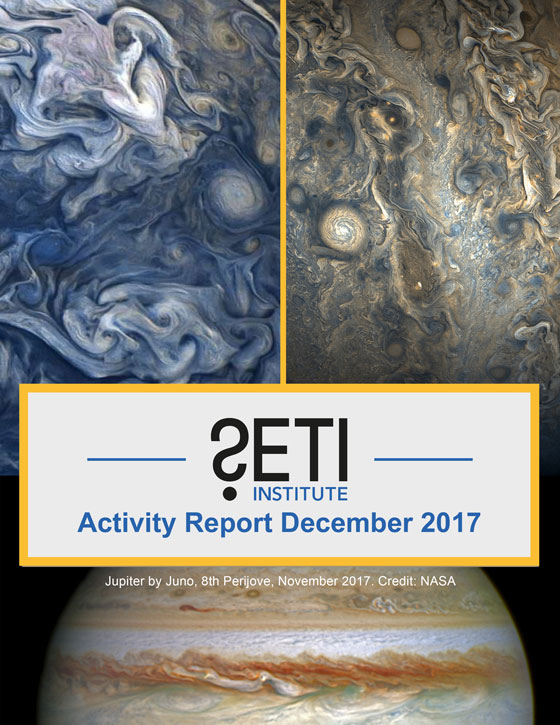The Curiosity Rover has taken images on Mars that some are speculating might possibly be fossils or signs of ancient life. The images depict very small – only up to 5 millimeters long – oblong features. Scientists are unsure of what exactly these features are, although SETI Institute scientist Pascal Lee suggested that the most likely explanation is that they are mineral in nature. He added, “the Curiosity images really pique our curiosity.”
- Science.com: Curiosity Rover Spots Weird Tube-Like Structures on Mars
- Express: Life on Mars: NASA Rover Finds ‘Unique Fossils’ on Red Planet
- Sputnik News: Bio-Traces on Mars? NASA’s Curiosity-Filmed Objects ‘Pique Our Curiosity’ Indeed
The Quadrantid meteor shower can still be seen until January 17, although it peaked on January 3. The asteroid – or ‘rock comet’ – known as 2003 EH1 that is believed to have caused the Quadrantids was discovered by SETI Institute scientist Peter Jenniskens who leads the NASA sponsored Cameras for Allsky Meteor Surveillance (CAMS) project in Northern California.
- KFVS 12: Meteor Shower Peaks Tonight!
The mystery surrounding the periodic dimming of Tabby’s Star -- KIC 8462852 – may have been solved at last. Located 1,300 light years away from Earth, Tabby’s Star has fascinated the scientific community with its unexplained, unpredictable dimming, sometimes by as much as 20%. Theories have included speculation that the dimming was caused by an alien megastructure or Dyson sphere. The SETI Institute has observed Tabby’s Star with its Allen Telescope Array, but found no evidence of extraterrestrial intelligence.
New observations reported in a paper in the Astrophysical Journal show that the dimming was more likely caused by ordinary dust. Observations will continue when the star can be seen again in February or March.
People may continue to believe that Tabby’s Star’s behavior is caused by aliens because, as Seth Shostak, Senior Astronomer at the SETI Institute noted, “Aliens are the duct tape of science.”
- Newsweek: KIC 8462852: How a Mysterious Star Went from Alien Megastructure to Dust Magnet
- Pressreader: So, No, Probably Not a Mega-Giant Alien Spaceship
- The Christian Science Monitor: ‘Alien Megastructures’ Debunked. Why Are We So Quick to Assume It’s Aliens?
NBC News asked top scientists, including Seth Shostak, Senior Astronomer at the SETI Institute, for their 2018 predictions. What did Seth have to say?
"It’s possible that a replacement for Pluto will be found — not literally a world to take its place, but one that can legitimately be called the ninth planet. Caltech astronomers Mike Brown and Konstantin Batygin have accumulated indirect evidence for an object that’s more than twice the diameter of Earth, but 10 times as far from the Sun as Pluto. The hunt is on to find it, and the news will be big if astronomers succeed in bagging this prey. It will add a super-Earth to our solar system — one we can both study and possibly visit — and will give school kids a coveted ninth planet to love." (Seth Shostak, NBC News)
A recent episode of StarTalk Radio featured Seth Shostak, Senior Astronomer at the SETI Institute and host of the Big Picture Science radio program in conversation about Proxima b.
- Star Talk Radio: Exploring Our ‘Neighboring’ Exoplanet Proxima b & Tabby’s Star
The Pentagon revealed that it has investigated UFOs, but the project didn’t provide conclusive evidence of alien visits to Earth. Seth Shostak, a Senior Astronomer at the SETI Institute, notes in an article for NBC News:
"The Pentagon study is certainly interesting, but not because it proves alien visitation. Of course, you can be sure that the “disclosure” folks will soon be claiming that UFO evidence is still being covered up. Conspiracy theories never end."
- SETI.org: Pentagon Studies and SETI
- NBC News: UFO Believers Got One Thing Right. Here’s What They Got Wrong.

The SETI Institute is a world-class center of scientific research. But that’s not all we do. In addition to the Carl Sagan Center for Research, our Center for Education and Center for Outreach work to share knowledge and learning with all humanity. The Center for Education promotes STEM education that teaches and excites children, young adults, and educators, while the Center for Outreach engages with the general public through a variety of digital, print and in-person initiatives.
Download the whole November 2017 activity report.
Last week’s encore presentation Weather Vain, delved into meteorology, weather forecasting, and even geoengineering. This week, Are Animals Really That Smart? wonders, amongst other things, whether people own cats or the other way around.
Last week SETI Institute President and CEO Bill Diamond sat down with Nathalie Cabrol, Director of the Carl Sagan Center at the SETI Institute. Nathalie has just published a paper in the January issue of Astrobiology about the coevolution of environment and life, and what it means for Mars exploration.
All past Facebook Live videos can be seen on the SETI Institute’s Facebook page at https://www.facebook.com/SETIInstitute/.
- Long Now Foundation: January 16, San Francisco, CA Franck Marchis will present a talk: Another Pale Blue Dot: Inside SETI Institute’s Search for Exoplanets
- SETI Talks: January 23, Menlo Park, CA SETI Institute Researcher Matija Cuk and Meg Scwamb of the Gemini Observatory in Hawai’i will discuss ‘Oumuamua
- Rencontre du Vietnam on Exoplanetary Science: February 25 – March 2, Quy Nohn, Vietnam Franck Marchis will present





